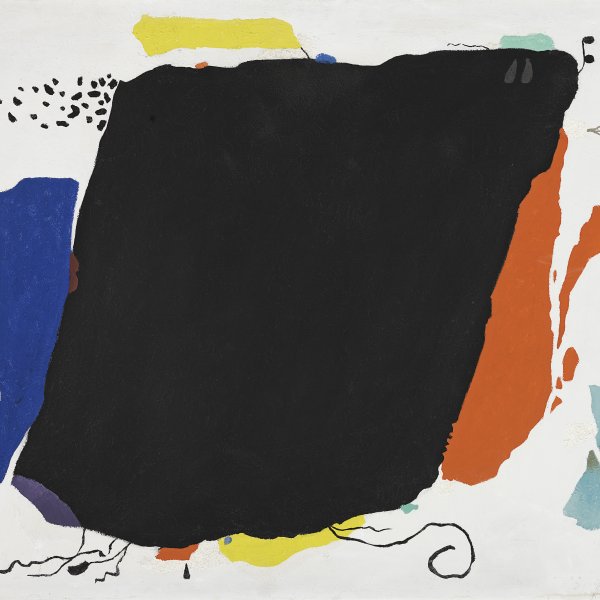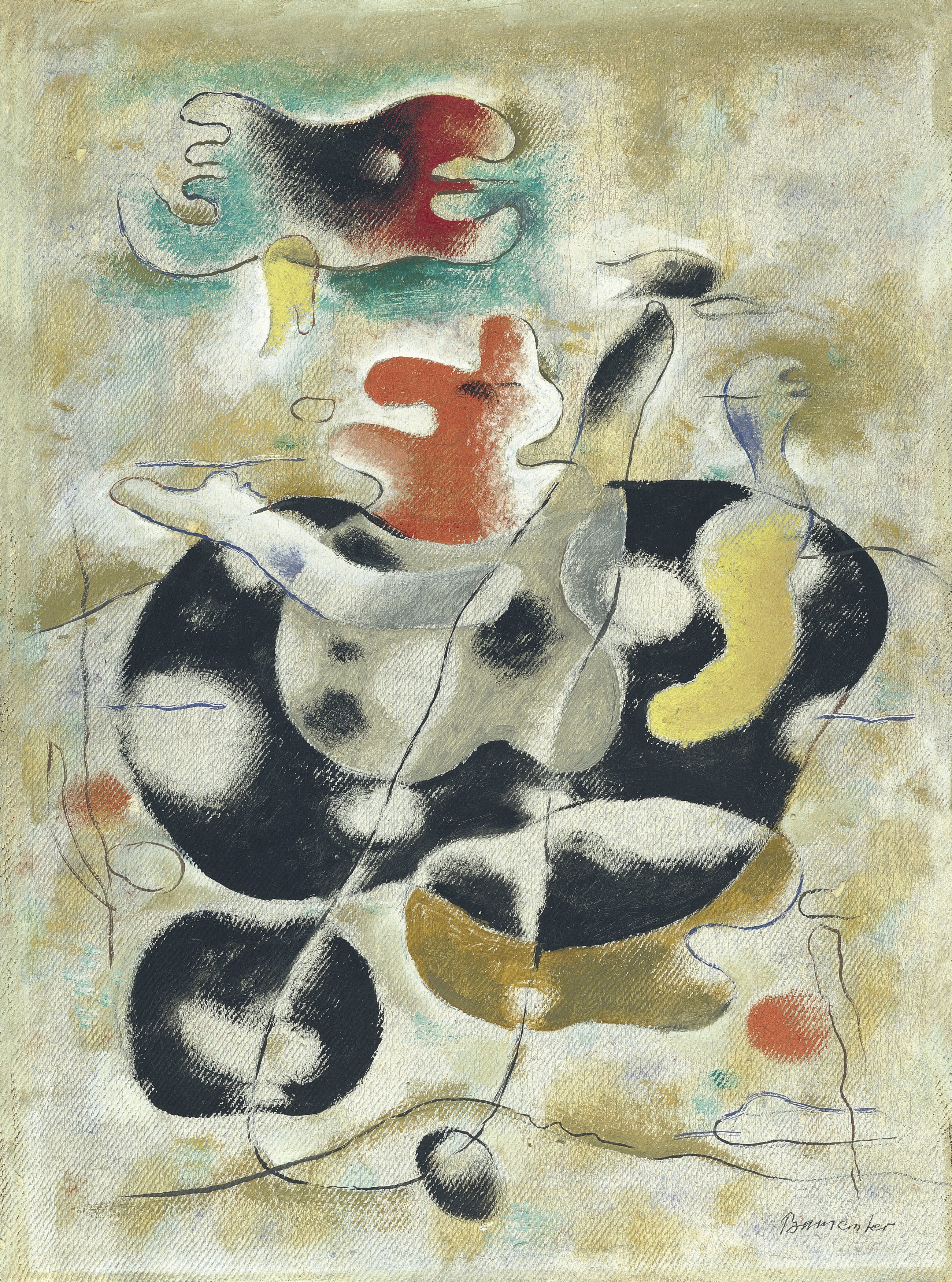Eidos Floating
Among the last works that WilIi Baumeister produced before the outbreak of the World War II is the Eidos series, consisting of seven oils, each about 100 x 80 cm, numbered from I to VII and executed between 1938 and 1939. In addition to this series there were another 46 paintings with titles that include the word Eidos, dated between 1939 and 1941. The resonance in the artist's work of the Eidos pictures thus extends to 1941 at the least. These pictures have certain very characteristic formal features, also shared by other works from the same period, such as the Stone Garden series. The origin of the artist's interest in the forms of amoeba, spindles, clouds and suspended shapeless masses evident in the Eidos paintings goes back to 1931, when Baumeister gradually abandoned the imagery closer to the constructive language of his earlier work in paintings such as the four that make up the series of Flamelet Pictures. However, it was between 1936 and 1939 in particular that Baumeister explored the world of floating abstract elements, connected with the work of Miró and related to Léger's "backgrounds", in works such as the ones that he called Line Pictures, Floating Forms and Ideograms. The changes introduced by the groups of works produced in the 1930s are evaluated by WilIi Grohmann as follows: "Baumeister increasingly cuts himself off from reality and paints pictures with realities that conjure up our dreams." The artist himself provides an explanation in a letter dated 12 May 1936 written to Eduardo Westerdahl, the author of the first monograph on Baumeister (1934): "Expressed crudely, I am now tending towards the liberties of Surrealism, to the pictorial and free, in contrast to composition. As for colour, I always aspire to strength and nuance, contrast and harmony at the same time [...] I am surprised at Miró's energetic colours. I have never seen one of his originals. Although I like his impetus and his inventions very much, I am rather sceptical about him in some aspects. Surrealism's strength undoubtedly lies in literature."
Baumeister's Formalism lies at the opposite extreme to the type of painting with literary implications that was developed by some of the Surrealist painters, although not by Miró. However, his affinity with an abstract inventiveness that had a strongly pictorial quality, in which the line developed its own expressive values and in which the artist played with the aesthetic contribution of textures and qualities, had other points of reference apart from Miró. These included the genius of Paul Klee and other artistic practices that were followed by a minority of the painters who belonged, like Baumeister, to the Abstraction-Création group and were shared, for example, by Hans Fischli, Enrico Prampolini and Wolfgang Paalen. During the 1930s Baumeister also began to study and to assimilate into his own work the Prehistoric wall painting of the Spanish Levante and Altamira, and to emphasise the importance of "the inherent energies of the means of artistic expression", as he states in his book Das Unbekannte in der Kunst. The attention he paid to Prehistoric art was accompanied by the development of investigations into painting processes and technical experiments, which he carried out with Oskar SchIemmer between 1938 and 1943 in Kurt Herbert's paint factory in Wuppertal.
The composition of Eidos Floating comes from a very marked use of the technical media of expression as energies which, in the artist's words, "make visible" the unknown. Baumeister applies oil paint to a prepared canvas with a very coarse weave. The mesh of the canvas is scored by countless parallel diagonal lines, running from bottom to top and from left to right. This modulation of the canvas is exploited expressively in the picture, on the one hand to emphasise an ascending feeling in the dynamics of the composition, and on the other hand to achieve chiaroscuro effects with an appearance of "texture" in the shapes. We cannot strictly speak here of chiaroscuro effects, as there is not a suitable development of the relief in the composition, but rather of the presence of a chiaroscuro that derives from the juxtaposition of dark, intermediate and light areas. It is precisely in the transitions of highlights that, instead of making mixtures with white, the painter uses the fabric of the canvas to achieve half-tones. The colour is applied more superficially and so does not penetrate the deeper parts of the fabric, and thus appears brighter. The image thus works in terms of a volumetric development and also a dynamic effect, starting from the possibilities inherent within the material itself, as if it provided the forms with an impulse for their volumetric growth.
The artist presents us with a process of development of forms. According to Baumeister: "Materials, whether wood, clay or glass, have their own characteristic form, and external influences mark their destiny: the water in the stream erodes the pebble, wood is washed by the sea, which eats away the shoreline, sand is rippled by the effect of the wind. On the other hand there is the active development of the form of organisms, working from the inside to the outside. The forms that can be imagined are infinite. For the artist there is thus no limit, for example, to the forms that the eye has learnt to appreciate by chance." Eidos Floating consists of a group of shapes that are non-representational, although organic in appearance, standing out against a background of light colours scored by a few lines that allow us to intuit a space and a horizon. Almost all these figures accumulate in the central part of the picture. In the top corner, alone and strongly emphasised by the richness of the colours, there is a biomorphic element and a horizontal development, in which one vaguely intuits a head with eye, tongue, lips and hair. Their arrangement points to the alarmed anthropomorphism of Picasso's Guernica and, consequently, the situation of war existing at the time.6 The main group of figures is a layering of shapes which recall amoebas, palettes, and occasionally plant-like elements. There is no clear foreground and background in this layering, but there is a relative order and an impression of transparency in the bodies. All of them, even the darkest, are translucent and partake of the sensation of light, changing, viscous condensations. This shapeless, fluctuating imagery does indeed ultimately acquire a biomorphic connection, since its abstract quality does not prevent us from seeing it as an amplification of a microscopic world. The organic connection of the abstract shapes suggests fertility and an ability to grow to what in principle appears to be a representation of the unknown. In this way the picture acquires a possible existence in nature, a status of reality. Baumeister says: "Every shape that can be conceived is present in nature and can be shown. Probably nothing can be invented that cannot also be discovered. The artist will only recognise those shapes that he can use to express himself. What is suitable in the human being, that in which he recognises a symbol of himself."
Eidos Floating shows an accumulation of suspended shapes, touching one another or arranged in a strong, ambiguous interrelationship, presented, despite the abstruse, almost parodic quality, as a budding body, a corporeal jumble that transcribes an experience of living space. "Floating, flying forms are representations of sensations. The form in which the human appears howls in many fashions, " says Baumeister. What the artist invents and creates, in his exploration of expressive media, is a cluster of grotesque, unconsolidated, mutant biomorphic shapes, which rears up into space as a human sign.
Javier Arnaldo






